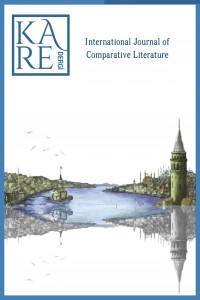ILIJA TROJANOW’UN KOCA DÜNYADA KURTULUŞ PUSUDA ROMANINDA HAYATI ANIMSAMAK VE ANIMSATMAK
Çağdaş Alman Edebiyatı, Anımsama Edebiyatı, Otobiyografik Bellek, Ilija Trojanow
REMINISCING AND RECOLLECTION OF LIFE IN ILIJA TROJANOW’S NOVEL THE WORLD IS BIG, AND SALVATION LURKS EVERYWHERE
Ilija Trojanow, Contemporary German literature, Reminiscence literature, Autobiographical memory,
___
- Assmann, J. Communicative and Culture Memory. In: Astrid Erll, Nünning Ansgar, (Hrsg.). Cultural Memory Studies: An International and Interdisciplinary Handbook, Berlin, Walter de Gruyter, 2008.
- Bauer, J.J., McAdams, D.P. ve Pals, J.L. Narrative identiy and eudaimonic wellbeing. Journal of Happiness Studies, 9 (1), 81-104, 2008.
- Bluck, S., Habermas, T. The Life Story Schema. Motivation and Emotion 24, 121–147, 2000. https://doi.org/10.1023/A:1005615331901
- Bojčeva, S. Erinnerungskulturen in der Literatur Zur Aufarbeitung der kommunistischen Vergangenheit Bulgariens in den Romanen von Ilija Trojanow, Dimitre Dinev und Sibylle Lewitscharoff. In: Zeitschrift für Balkanologie, 2016, 52(1). https://www.zeitschrift-fuer-balkanologie.de/index.php/zfb/article/view/448
- Dämmrich, H. und Ingrid G. Themen und Motive in der Literatur. Tübingen und Basel, Trento: Francke Verlag, 1995.
- Demiray, B. Otobiyografik Bellek Araştırmalarında Kullanılan Yöntemler ve Metodolojik Gelişmeler . In: „Hayatı Hatırlamak. Otobiyografik Belleğe Bilimsel Yaklaşımlar“, editor Sami Gülgöz, Berivan Ece, Sezin Öner, İstanbul: Koç Üniversitesi Yayınları, 2018, 27- 49.
- Dimitrowa, I. P. Ilija Trojanow: Reisen und Schreiben im Zeitraum 1993-2008. Versuch einer Monographie unter Berücksichtigung verschiedener Aspekte der Reiseliteratur. Dipl-Arbeit, Universität Wien, 2010, 12-13.
- Erll, A. Kollektives Gedӓchtnis und Erinnerungskulturen. Stuttgart/Weimar: Walter de Gruyter, 2005.
- Herbert, U. Geschichte Deutschlands im 20. Jahrhundert. München: Verlag C. H. Beck, 2014.
- Horváth, A. Erinnerungen an die Heimat. Kulturvorstellungen in Ilija Trojanows "Die Welt ist groß und Rettung lauert überall". In: Dialogische Erinnerung, Hrsg. Kovács, Kálmán; Horváth, Andrea; Pabis, Eszter, (Debreceni: Egyetemi Kiadó), 2017, 103-116.
- Horvàth, A. Noch vor der Grenze. Das Bild der eigenen Kultur in Ilija Trojanows Die Welt ist groß und Rettung lauert überall. In: Interkulturalität und Kognition, 2013, 25-33. https://trojanow.de/autor/biographie/
- Knopp, E. Letting the Subaltern Laugh – How Humour Works in Die Welt ist groß und Rettung lauert überall (The World is Great and Salvation lies Everywhere in Wait) and Der Weltensammler (The Collector of Worlds). In: Ilija Trojanow, Swansea Series in Contemporary German Writers and Film-Makers Vol.1, ed. Julian Preece, 2012. Accessed on 15.09.2022, https://www.researchgate.net/profile/Julian_Preece/publication/266317056_Ilija_Trojanow/links/5f199adc92851cd5fa3f5b50/Ilija-Trojanow
- Paterno W., Abschottung führt zum Friedhof. Der Schriftsteller Ilija Trojanow, Autor des Bestsellers Der Weltensammler, über Indien, das Gastland der heutigen Frankfurter Buchmesse, die Spiritualität des Subkontinents und den Kampf der Kulturen,2006, 148–150.
- Rubin, D. C, The Basic-Systems Model of Episodic Memory. In: Perspect Psychol Sci. 1(4) 2006, 277-311. doi: 10.1111/j.1745-6916.2006.00017.x
- Trojanow, I. Die Welt ist groß und Rettung lauert überall. München und Wien: Carl Hanser Verlag, 1996.
- Wägenbaur, T, Kulturelle Identität oder Hybridität?. In. Z Literaturwiss Linguistik 25, 1995, 22–47. https://doi.org/10.1007/BF03377216
- ISSN: 2536-4596
- Yayın Aralığı: Yılda 2 Sayı
- Başlangıç: 2016
- Yayıncı: Hasan BAKTIR
ILIJA TROJANOW’UN KOCA DÜNYADA KURTULUŞ PUSUDA ROMANINDA HAYATI ANIMSAMAK VE ANIMSATMAK
Gonca KİŞMİR, Derya Koray DÜŞÜNCELİ
FANTEZİ EDEBİYATINA JUNGİYEN EKOPSİKOLOJİK BİR YAKLAŞIM: KURAMSAL ÇERÇEVE
Banu AKÇEŞME, Cansu ÖZDEMİR AĞLAR
WİLHELM DİLTHEY FELSEFESİNDE İNSAN PROBLEMİ
Arslan TOPAKKAYA, Gülsima URTEKİN
İNGİLİZ RÖNESANS ŞİİRİNDE PETRARCH KARŞITI UNSURLARA DAİR KARŞILAŞTIRMALI BİR İNCELEME
